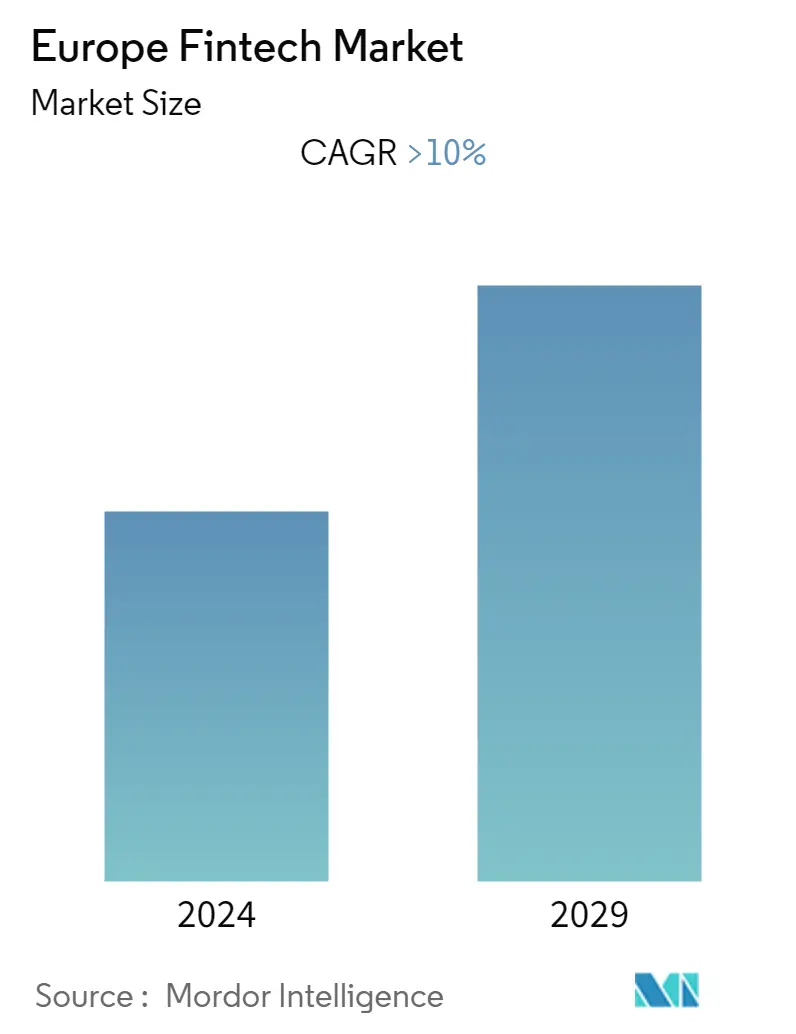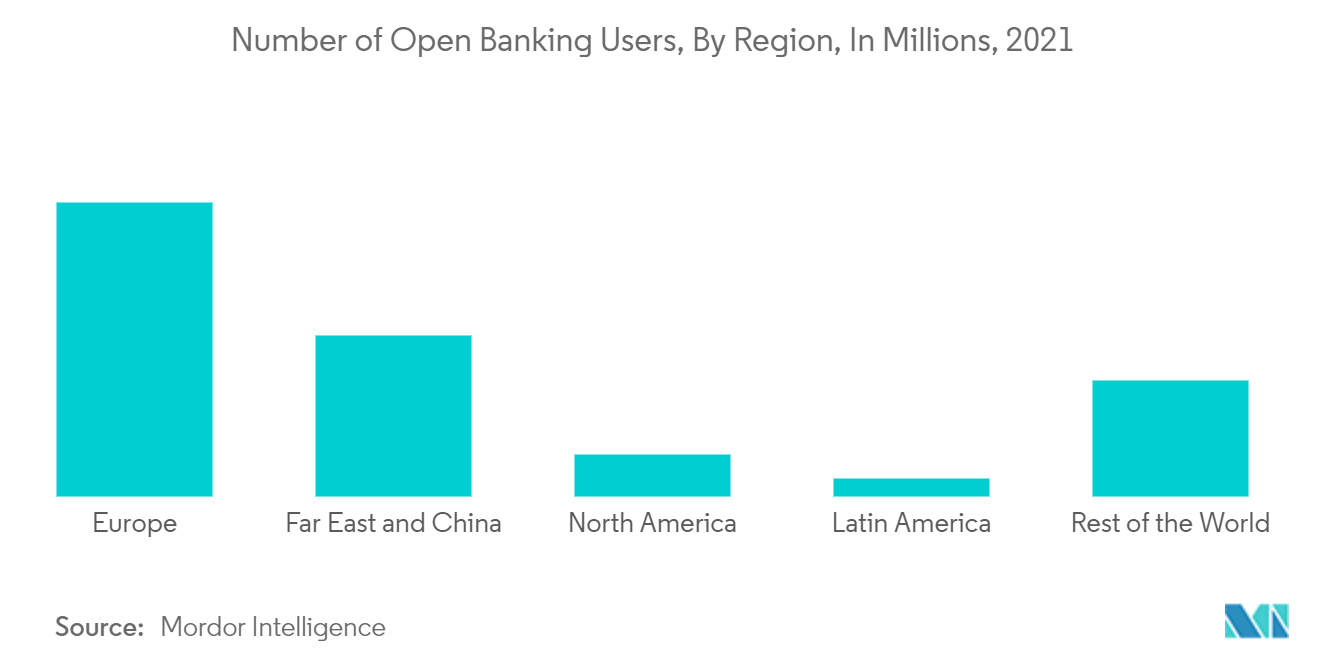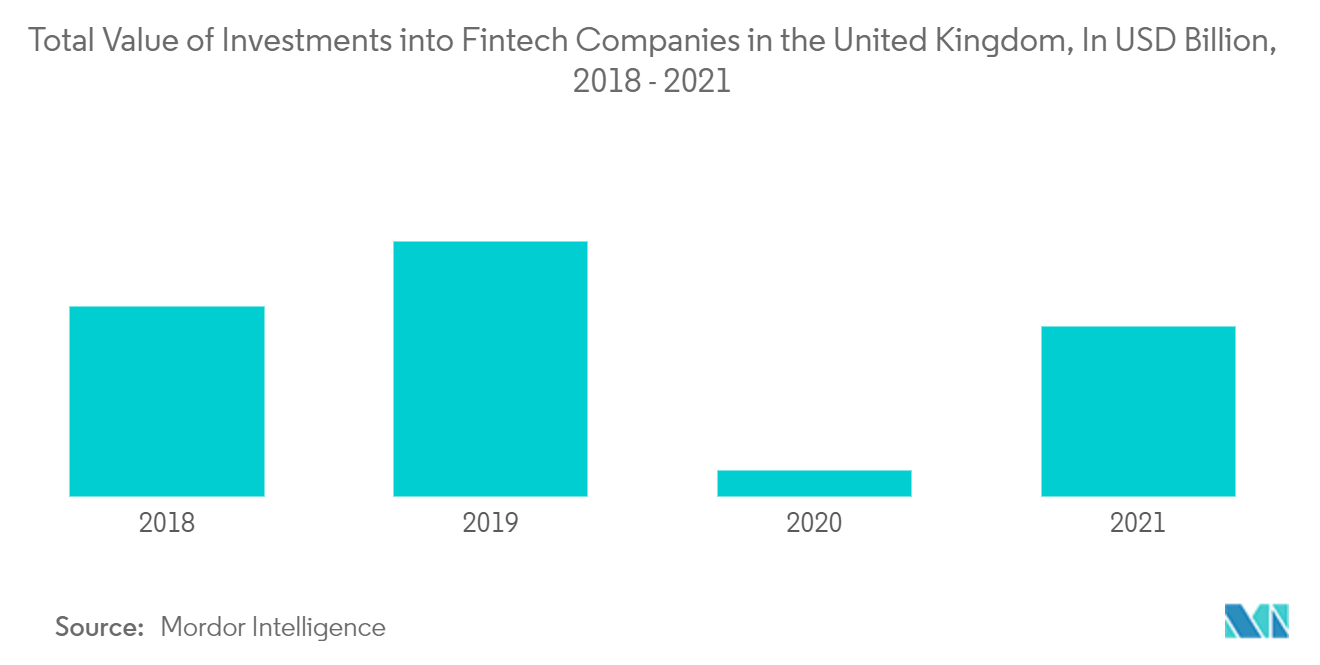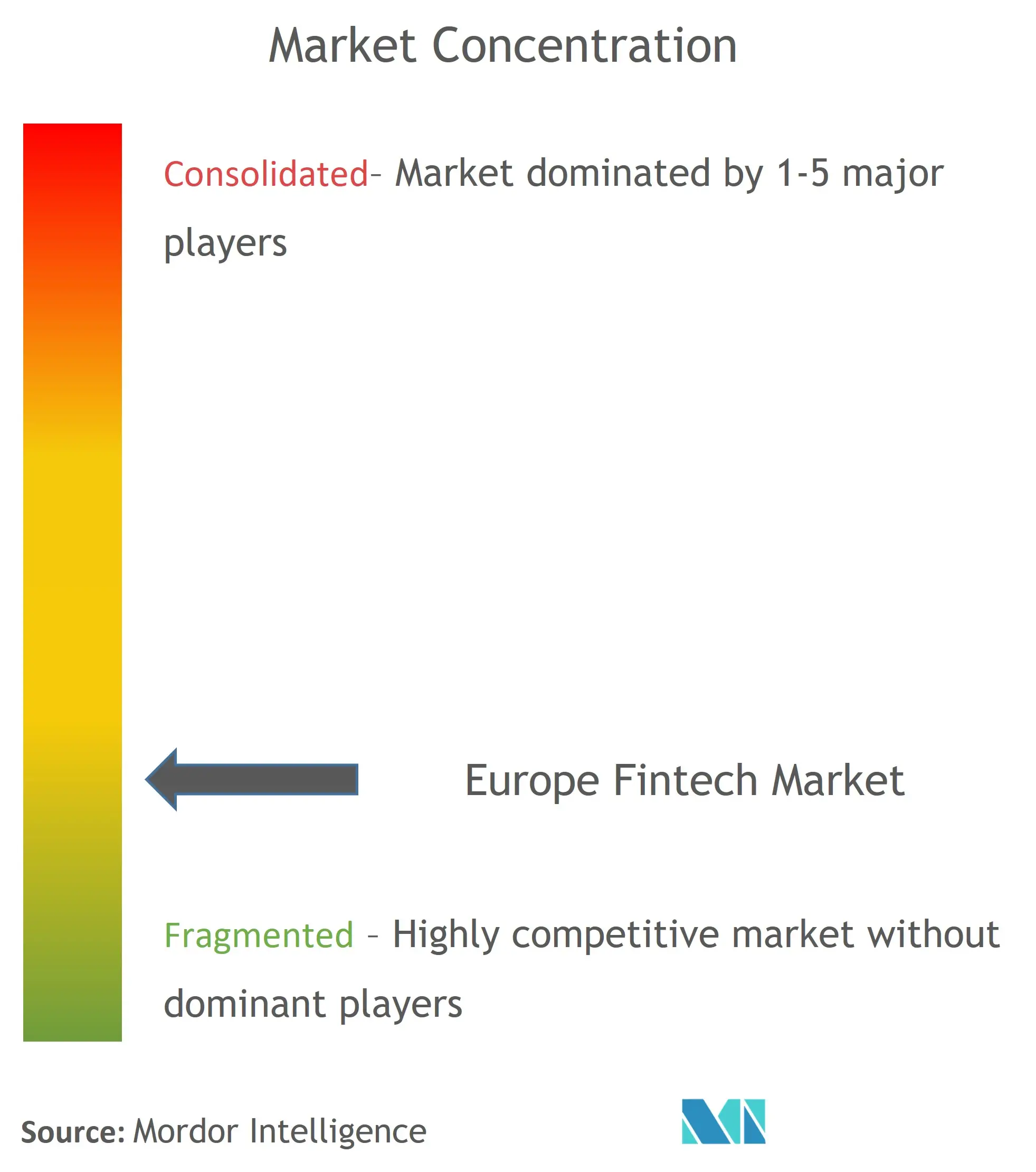Europe Fintech Market Size

| Study Period | 2020 - 2029 |
| Base Year For Estimation | 2023 |
| Forecast Data Period | 2024 - 2029 |
| Historical Data Period | 2020 - 2022 |
| CAGR | 10.00 % |
| Market Concentration | Medium |
Major Players.webp)
*Disclaimer: Major Players sorted in no particular order |
Europe Fintech Market Analysis
The Europe fintech market is estimated at USD 3,600 billion (in terms of transaction value) in the current year and is poised to register a CAGR of more than 10% during the forecast period.
Europe is the cradle of fintech since it is a global leader in the growth of both financial institutions and financial markets. Fintech companies in Europe are worth twice as much as any other tech sector on the continent. The region, which leads the rest of the world in terms of energy and internet access, provides ideal conditions for fintech growth. Furthermore, by 2025, further technological infrastructure will deliver 5G network coverage to 75% of the region's population. With several European countries (e.g., Switzerland, the Netherlands, and the Nordic countries) dominating the 2020 Global Innovation Index, Europe provides a corporate environment suitable for innovation and technology development.
COVID-19 scenarios show European economies contracting by 11% in 2020 and have adversely affected the fintech ecosystem. Fintech agreements have decreased as investors prefer to invest in mature companies rather than early-stage deals. Experts from the Emerging Payments Association found a significant contraction in the market, with fintech funding in Q1 2020 already down by USD 2 billion from Q4 2019. As governments shut down and investors took stock, the industry appeared vulnerable at the start of 2020, hitting a three-year low. In 2020, European fintech raised a total of USD 9.01 billion during COVID-19. The industry looks to have recovered, aided by a transition to digital and banks' increased interest in new infrastructure. Until June 2021, European fintech has raised USD 11.16 billion, trumping the USD 9.98 billion raised across the whole of 2019 - the previous highest year on record.
New venture capital fintech investments in Europe have been growing rapidly since the emergence of the COVID-19 pandemic. Fintech also looks set to maintain its position as the most funded area in European tech. European fintech has attracted an influx of cash from both the United States and Chinese investors, drawn in by the mounting success of the first-generation fintech. That also had a knock-on effect on valuations, meaning there are now more than 30 fintech unicorns in Europe, and several more are soon slated to reach the USD 1 billion milestones. Europe makes up 17% of the global cumulative valuation of fintech (around USD 2.26 trillion), its largest venture capital investment category receiving 20% of all venture capital in Europe: a higher percentage than in Asia and the United States.
Europe Fintech Market Trends
Favourable Regulatory Landscape is Driving the European Fintech Market
In Europe, regulatory tailwinds have helped transform the continent into a hotbed of fintech activity. Open banking and PSD2 have enabled the rise of challenger banks and middleware data players and have also been leading to market consolidation. Open banking, payments, and transaction banking are the top three areas of development in the European Fintech ecosystem.
Over the last few years, the European fintech scene has seen significant expansion. Open banking is one of the main drivers of this expansion. As a result, financial institutions and fintech are collaborating to provide consumers across Europe with more creative, user-friendly products. According to EY's Global FinTech Adoption Index, European customers are receptive to the idea of non-financial players selling financial solutions. Fintech adoption across Europe, particularly in nations like the Netherlands, the United Kingdom, Germany, Sweden, and Switzerland, is significantly above the global average of 64%, according to the survey.
Hometrack, a provider of insight and intelligence to the UK mortgage market, appointed Moneyhub, the Open Finance data, intelligence, and payments platform for customer-centric organizations, as its preferred Open Banking partner. The integration of FinTech Moneyhub's Open Banking technology into Hometrack's Credit Risk Hub will facilitate streamlined mortgage journeys for lenders, brokers, and consumers alike.

The United Kingdom has Dominated Fintech Funding in Europe
The United Kingdom has long dominated fintech funding in Europe and globally. It is second only to the United States in terms of investment in space, with its fintech getting another small boost from the country's Government's Future Fund scheme.
Nonetheless, the UK's lead in Europe narrowed last year. Germany, Sweden, and France have all seen a record year so far and are now gaining on the UK, according to Dealroom data. All three countries saw much larger increases in funding than the UK last year.
Moreover, the United Kingdom made up 53% of Europe's fintech funding in 2019, with 41% until June 2021. The United Kingdom's fintech share is valued at nearly USD 40 billion, followed by the Netherlands.
The United Kingdom is expected to remain a key financial hub in Europe and an attractive platform for start-ups as it has a good trade relationship that it has with the United States and other Asian fintech hubs. Fintech landscapes are likely to change, and the extent of this change will heavily depend on the outcome of the current negotiations.

Europe Fintech Industry Overview
The research examines the top companies in the fintech business in Europe. Digital payment schemes are expanding within countries, while cross-border and pan-euro region instruments are not yet common. Competition is forcing many traditional banks to adopt fintech instruments, either in-house or by acquisition. These developments could improve the efficiency and reach of financial intermediation while also adding to profitability pressures for some banks. Start-ups are pursuing platform-based approaches under minimal regulation. The current situation favors the companies which can provide a 'Buy Now, Pay Later' solution or quick working capital for SMEs, run a credit or loan marketplace, offer user-friendly apps for personal or business banking, or build a way for users to cut costs on things like transferring money online, raising funds and other types of transactions. Some of the major players dominating the market include Adyen, Nexi, Revolut, Klarna, N26, Oaknorth, Monzo, Rapyd, Transferwise, and Funding Circle.
Europe Fintech Market Leaders
-
Adyen
-
Nexi
-
Klarna
-
N26
-
Revolut
*Disclaimer: Major Players sorted in no particular order

Europe Fintech Market News
- Mar 2022: Adyen, a global financial technology platform of choice for leading businesses, planned to expand beyond payments to build embedded financial products. These products will enable platforms and marketplaces to create tailored financial experiences for their users, such as small business owners or individual sellers. The suite of products will allow platforms to unlock new revenue streams and increase user loyalty.
- Jun 2021: Raisin and Deposit Solutions, two big German fintech startups and rivals, were planning to unite to form a pan-European group that will offer innovative, API-based B2B and B2C products in the savings and portfolio management areas. The company will keep its New York, London, Manchester, and Madrid offices open. Raisin DS will combine the best practices in B2B and B2C - 'every day' savings and investment products - to form a new enterprise.
Europe Fintech Market Report - Table of Contents
1. INTRODUCTION
- 1.1 Study Assumptions and Market Definition
- 1.2 Scope of the Study
2. RESEARCH METHODOLOGY
3. EXECUTIVE SUMMARY
4. MARKET INSIGHTS AND DYNAMICS
- 4.1 Market Overview
- 4.2 Market Drivers
- 4.3 Market Restraints
-
4.4 Porter's Five Forces Analysis
- 4.4.1 Threat of New Entrants
- 4.4.2 Bargaining Power of Buyers/Consumers
- 4.4.3 Bargaining Power of Suppliers
- 4.4.4 Threat of Substitute Products
- 4.4.5 Intensity of Competitive Rivalry
- 4.5 A Brief on Internet and Smartphone Penetration in the Region
- 4.6 Insights on Key Regulations and Industry Policies Impacting the Fintech Market in the Region
- 4.7 Impact of COVID-19 on the Market
5. MARKET SEGMENTATION
-
5.1 By Service Proposition
- 5.1.1 Money Transfer and Payments
- 5.1.2 Savings and Investments
- 5.1.3 Digital Lending and Lending Marketplaces
- 5.1.4 Online Insurance and Insurance Marketplaces
- 5.1.5 Other Service Propositions
-
5.2 By Country
- 5.2.1 United Kingdom
- 5.2.2 Germany
- 5.2.3 France
- 5.2.4 Rest of Europe
6. COMPETITIVE LANDSCAPE
- 6.1 Market Concentration Overview
-
6.2 Company Profiles
- 6.2.1 Adyen
- 6.2.2 Nexi
- 6.2.3 Klarna
- 6.2.4 N26
- 6.2.5 Revolut
- 6.2.6 Oaknorth
- 6.2.7 Monzo
- 6.2.8 Rapyd
- 6.2.9 Transferwise
- 6.2.10 Funding Circle*
- *List Not Exhaustive
7. MARKET OPPORTUNITIES AND FUTURE TRENDS
8. DISCLAIMER AND ABOUT US
** Subject To AvailablityEurope Fintech Industry Segmentation
An understanding of the present status of the Europe fintech market, along with detailed market segmentation, current market trends, changes in market dynamics, growth opportunities, and an in-depth analysis of the market size and forecast for the various segments, is provided in the report.
Europe Fintech Market is segmented by Service Proposition (Money Transfer and Payments, Savings and Investments, Digital Lending and Lending Marketplaces, Online Insurance and Insurance Marketplaces, and Other Service Propositions) and Country (United Kingdom, Germany, France, and the Rest of Europe). The report offers Market size and forecasts for Europe Fintech Market in value (USD billion) for all the above segments.
| By Service Proposition | Money Transfer and Payments |
| Savings and Investments | |
| Digital Lending and Lending Marketplaces | |
| Online Insurance and Insurance Marketplaces | |
| Other Service Propositions | |
| By Country | United Kingdom |
| Germany | |
| France | |
| Rest of Europe |
Europe Fintech Market Research FAQs
What is the current Europe Fintech Market size?
The Europe Fintech Market is projected to register a CAGR of greater than 10% during the forecast period (2024-2029)
Who are the key players in Europe Fintech Market?
Adyen, Nexi, Klarna, N26 and Revolut are the major companies operating in the Europe Fintech Market.
What years does this Europe Fintech Market cover?
The report covers the Europe Fintech Market historical market size for years: 2020, 2021, 2022 and 2023. The report also forecasts the Europe Fintech Market size for years: 2024, 2025, 2026, 2027, 2028 and 2029.
What are the significant trends in the Europe FinTech Industry?
The significant trends in the Europe FinTech Industry are a) The Rise of digital payments, the emergence of digital investment platforms, and the growth of neo-banks b) The adoption of blockchain technology c) The increasing popularity of digital assets like cryptocurrencies and NFTs (Non-Fungible Tokens)
Europe Fintech Industry Report
The European fintech market is poised for significant expansion, driven by advancements in technology, regulatory support, and changing consumer behaviors. The market segments, including digital payments, money transfers, and online insurance, are rapidly evolving due to the increased use of smartphones and the internet, which enhance access to fintech services. Innovations in artificial intelligence and blockchain technology are also propelling the market, introducing new efficiencies and security measures in financial services.
Regulatory frameworks such as PSD2 and open banking are creating a conducive environment for innovation and competition, allowing European fintech companies to access essential banking data and improve their offerings. Despite facing challenges like cybersecurity risks and slower uptake in rural areas, the fintech market in Europe benefits from robust venture capital backing, especially in cloud-based solutions and API technologies that simplify and enhance consumer financial experiences.
Industry trends indicate a strong market growth trajectory, supported by comprehensive industry analysis and industry statistics. The market forecast suggests continued expansion, with market leaders driving innovation and competition. The market overview highlights the importance of market segmentation and market value in understanding the dynamics of the fintech sector.
The report example provides an in-depth look at the industry size and industry sales, offering valuable insights into market data and market predictions. The market review underscores the significance of industry research and industry outlook in shaping the future of fintech in Europe. The report pdf available for download offers detailed industry information and industry reports that are essential for stakeholders looking to capitalize on the opportunities within this dynamic market.



